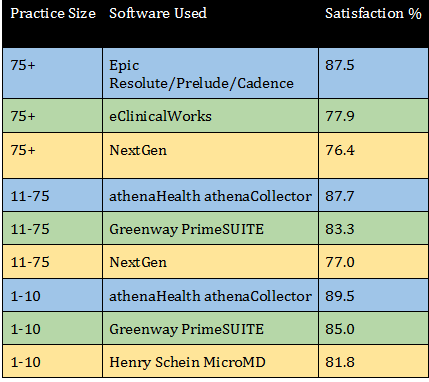Healthcare technology adoption is advancing at an ever-increasing rate, but satisfaction with many medical software systems is low. With the innumerable options, choosing the right practice management software has become nearly impossible.
The days of the paper chart, using faxes to communicate, whiteboards for scheduling, etc. are coming to an end. Software now manages almost every function of a medical practice. New software and hardware is released and/or updated weekly; figuring out which is best means wading through hundreds of options and making sense of what software has what features, what those features actually mean in terms of day-to-day workflow, and what features best fit workflows for a specific provider, office or organization.
The table below shows practice management systems with the highest provider satisfaction, sorted by organization size. KLAS, a healthcare technology ratings and research organization, performed the research, polling over 75 physicians in a variety of specialties and care organizations. All of these systems have similar feature sets; matching the knowledge of each product's specific features and its efficacy will allow us to determine the features that providers need from their practice management system in order to be satisfied.
Practice management software satisfaction
Source: KLAS 2013
The first and most obvious feature all of these practice management systems share is an integrated electronic health records solution. With healthcare IT interoperability still low, it makes sense that most providers prefer a pre-integrated solution. Epic's EHR, in particular, is notorious for being a "closed system" that is difficult to integrate with third-party software. While the data above reflects that providers at larger hospitals and clinics may be happy with Epic, smaller-sized organizations generally prefer other systems. There also could be some selection bias at play, as larger healthcare organizations are less likely to need to coordinate care with non-affiliated providers that may be using different systems. With reimbursement penalties for Medicare/Medicaid providers who haven't demonstrated 'meaningful use' of an EHR looming, it makes sense that physicians are more satisfied when their practice management software is pre-integrated with ONC-ATB approved software that will enable successful attestation.
It is also worth noting that in addition to simply providing an integrated EHR, each of these vendors' EHRs have been approved for stage two of meaningful use attestation, while most other electronic health records software has not.
Of course, alternatives to pre-integrated systems exist. Providers can select an open-source EHR/PMS, use one of the few vendors that offer an open application programming interface so third-party software can interface with their systems, or make sure that both software systems they need to use support the Health Level Seven data exchange format.
Another feature all of the top-rated systems share is an integrated patient portal. Patient portals save physicians time, generally increase patient satisfaction, and fulfill functions required of providers attesting for stage 2 of the meaningful use incentive program. All of the integrated patient portals here support pre-registration, so patients can provide demographic information before their visit, and online bill pay, potentially shortening the revenue cycle for providers.
Other shared features include support for the ICD-10 code mandate, document management capabilities with internal messaging/commenting and online fax, templates for encounter notes, billing, referral forms, etc., and robust accounting functions to enable claims management/scrubbing and collections. Also, each vendor offers a complementary system that supports machine integrations, enabling images or other machine-generated information to be stored, viewed and shared within the practice management and electronic health records software.
In short, these practice management systems enable high provider satisfaction because they come the closest to fulfilling the ideal healthcare IT scenario of a fully integrated, easy-to-use and ONC-ATB approved system that electronically manages almost every process in an office, clinic or care organization. With advances in clinical decision support, health maintenance and robotics, these systems could manage every process, maybe even including the ones performed by physicians.
Charles Settles is a product analyst at TechnologyAdvice. He covers topics related to Health IT, business intelligence, and project management. Connect with him on LinkedIn.


